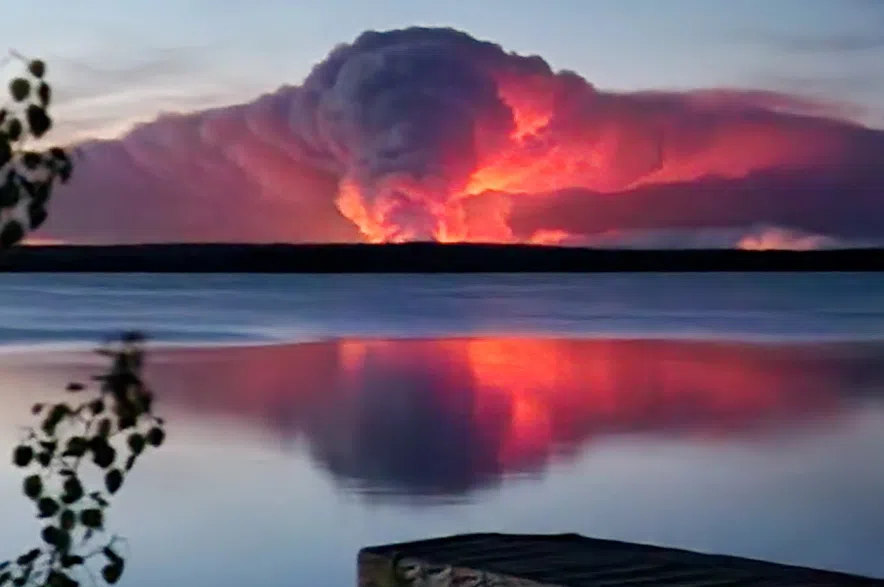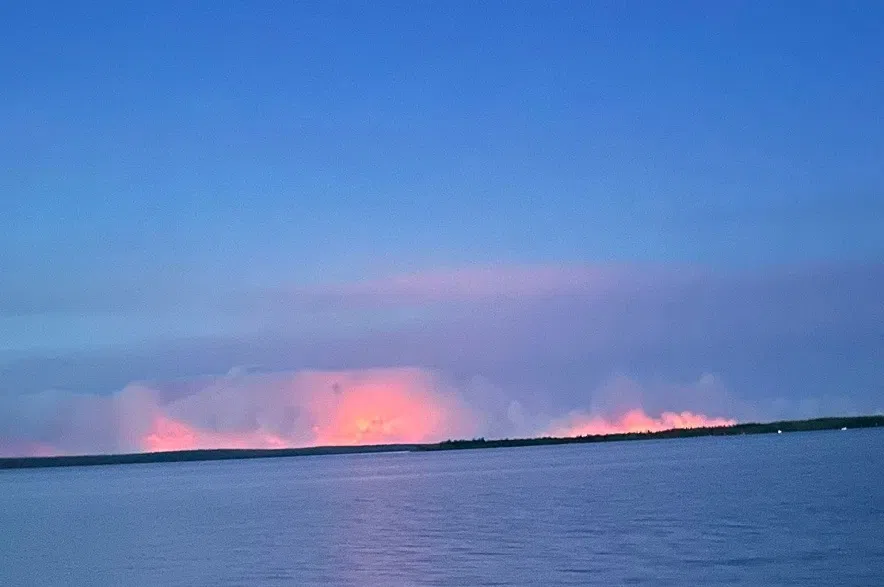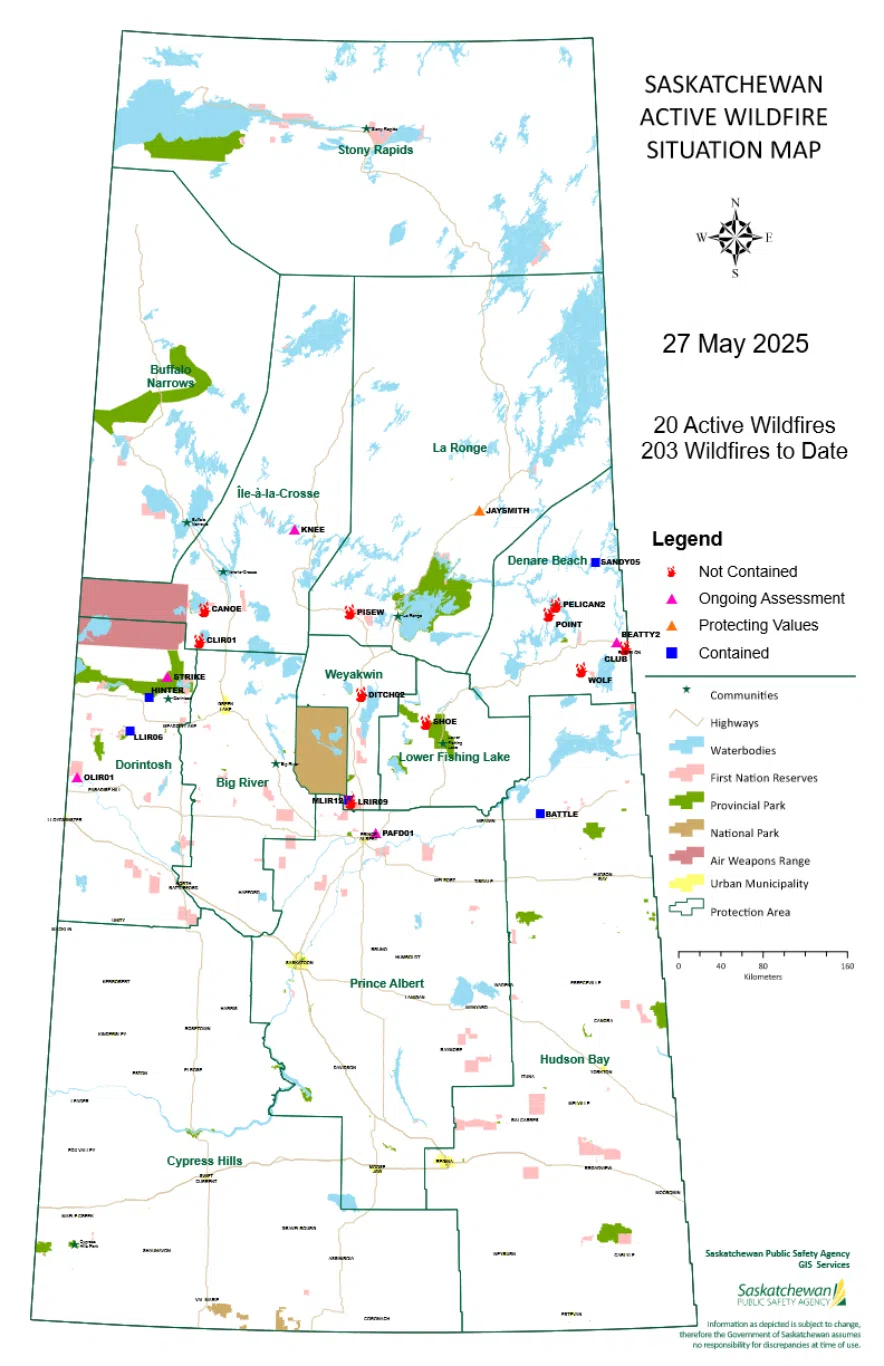Steve Roberts has been running wildfire operations for the Saskatchewan Public Safety Agency (SPSA) for 21 years and during that time he’s never seen a more busy or aggressive spring wildfire season.
“This early, this concentrated, with this kind of weather pattern… we’ve not recently seen anything like this,” he said.
Year to date, there have been 205 wildfires in the province, well above last year’s number of 165 fires at this time, and the five-year average of 124. Nearly all of the fires so far have been human-caused.
“It’s taking almost no effort to start a fire, and they are extremely aggressive, growing extremely fast. Even a small incident can quickly evolve in a short period of time to a major incident causing threats to the province,” Roberts said.
High daytime and warm night temperatures, low humidities and strong winds are moving active wildfires significant distances.
A look at the Camp and Shoe Fires burning in Saskatchewan before they combined, creating a 533,000 acre fire. (216,000 hectares)
These photos were sent in by a subscriber flying over the province. The massive fire is threatening Narrow Hills Provincial Park, and Lower Fishing… pic.twitter.com/Z5FFi6fHry
— The Hotshot Wake Up (@HotshotWake) May 27, 2025
The Shoe fire that started near Lower Fishing Lake and the Camp fire that started north of Snowden, have merged into a single uncontained blaze that is 216,000 hectares in size.
During a press conference Tuesday afternoon, the SPSA said flames reached the compound they had set up between the two fires and destroyed infrastructure including a camp kitchen, bunkhouse, equipment, a shack and a truck.
“During the course of the fire, we actually were required to evacuate the entire fire response team that was managing these fires to move them out of the way of this fire activity. So, 280 people were required to evacuate this fire while they were engaged in suppression efforts,” Roberts said.
SPSA evacuates to Candle Lake
As a result, the SPSA moved its incident command centre to the Resort Village of Candle Lake.
Earlier in the day, the Candle Lake Fire Chief Jim Arnold said they requested approval from SPSA to build a firebreak starting from Minowukaw along Highway 120 towards the Highway 265 junction.
He suggested the buffer may be one of the only things that saves the community from the blaze that is currently just over 20 kilometres away. Residents grew concerned when they heard that it could take a few days to obtain a permit required to build the firebreak.
SPSA president Marlo Pritchard said the agency has been working with the community for several weeks and have sent a mitigation specialist to look at a potential plan and how permits could be expedited, however the winds are currently pushing the fire away from the community.
“Really what it comes down to is that community right now is not in imminent threat. It has a fire in the vicinity so it’s not what we would declare an emergency… so there are requirements when we do mitigation efforts. We also want to make sure that the plan of future mitigation aligns with the environmental concerns and doesn’t make a situation worse,” said Pritchard.
“We’re not saying that it’s not a good idea. It’s just that we need to do our due diligence.”
He couldn’t give a timeframe on when a permit may be issued, but said they’d be working as quickly as they can with the specialists and the community.
SPSA requests more firefighters, equipment
To help fight the 21 active wildfires currently burning, the SPSA said it has made a request for more fire crews, equipment, and aircraft to be delivered to Saskatchewan.
The state of Alaska sent an airtanker a few weeks ago and Quebec has loaned the province its water bombing aircraft. Roberts said resources have been spread thin.
“We lose as often as we win. Success today can be erased tomorrow,” he said.
“We’ve deployed all of our resources. All of our resources that are typically required for the fire season have returned, are trained and are working, but again we rotate them through so that we not only can fight these big fires, but we have to be prepared to jump on any new start.”
He said their best opportunity to be effective is to grab small fires, keep them from getting big and then return to larger fires and continue to work.
While several areas are under evacuation, some residents have chosen to stay behind and fight the wildfires themselves in an effort to save their cabins — particularly in the Narrow Hills Provincial Park area by Lower Fishing Lake, East Trout Lake and Little Bear Lake. Some residents have expressed frustration with what they perceived to be a lack of response by the SPSA.
Roberts said residents may not necessarily see firefighters in every small community or subdivision, but staff have been in those vicinities to set up sprinkler units and put in dozer lines to break the fuel up. He said assigning crews is a very dynamic process that requires a command team to coordinate the efforts.

This photo was taken from Whelan Bay looking across Whiteswan Lake, north of Candle Lake, on May 25, 2025. (Carol Hogan/Submitted)
“We keep moving personnel as we reprioritize. Right now, the west side of the province has fairly moderate conditions… all of those staff have been relocated to these critical fires.
“So many of the staff fighting the fires in Candle Lake area … are actually from Buffalo Narrows, Île-à-la-Crosse and Dorintosh. We’ve already relocated the bulk of our resources and then as the fire threat changes on different flanks and fronts, we will reengage in those key areas and do more work and then we’ll shift priorities again to deal with those communities at the biggest threat.”
Wildfires of note on May 27
- The Jaysmith fire is 18,000 hectares in size and burning north of La Ronge. The community of Brabant Lake is being threatened.
- The Pisew fire at the base of Besnard Lake road access is 51,000 hectares. There are three suspected structures lost and one confirmed structure loss. The community of Hall Lake was evacuated.
- The Wolf fire, west of Denare Beach is threatening the Foran McIlveena Mine site nearby and forced its evacuation. It is currently 6,400 hectares.
- The Pelican2 fire, northeast of Pelican Narrows and close to the townsite is 850 hectares. The SPSA said four pieces of heavy equipment under contract with SaskPower have been lost to the fire.
- The Club fire, north of Creighton is 1,000 hectares.
- The Canoe fire is still relatively small at 25 hectares, but Canoe Lake First Nation has self-evacuated as a precaution.
- The Ditch02 fire burning near Weyakwin on Highway 2 north of La Ronge is about 160 hectares and was human-caused.
- The LRIR09 fire, west of Christopher Lake is 252 hectares in size and there is a potential of threatening local campgrounds and the community
- The CLIR01 fire burning on the west side of the province near Onion Lake is 155 hectares in size, but the SPSA confirmed eight cabins were lost in the blaze.
There are several evacuation alerts in effect including Whelan Bay, Pelican Narrows, Lower Fishing Lake, Brabant Lake, Hall Lake, Little Bear Lake subdivisions, East Trout Lake subdivisions and campgrounds, a few permanent residences at Narrow Hills, Piprell Lake and the McIlveena Mine site.
Highway closures are in place for highways 135, 910, 106, 120, 913 and 912.
There are currently 21 active wildfires burning in Saskatchewan; 10 of them are not contained.
— by Teena Monteleone













